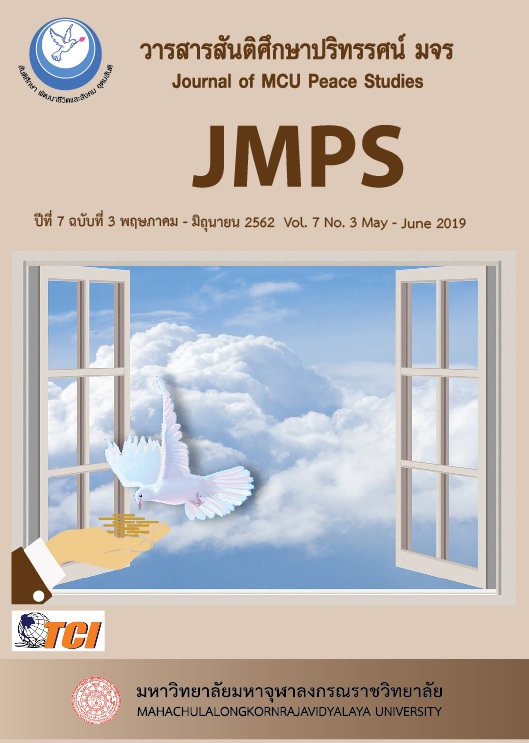รูปแบบการป้องกันพฤติกรรมเสี่ยงต่อยาเสพติดของนักเรียน ชั้นมัธยมศึกษาในเขตพื้นที่ตะเข็บชนแดนลุ่มน้ำโขง
Main Article Content
บทคัดย่อ
การวิจัยครั้งนี้มีวัตถุประสงค์ 1) สร้างรูปแบบการป้องกัน และ 2) ยืนยันรูปแบบการป้องกัน พฤติกรรมเสี่ยงต่อยาเสพติด กลุ่มตัวอย่างและกลุ่มผู้ให้ข้อมูลสำคัญ ได้แก่ บุคคลที่เกี่ยวข้องกับการป้องกัน พฤติกรรมเสี่ยงต่อยาเสพติด 15 คน และผู้เชี่ยวชาญในการป้องกันปัญหายาเสพติด 5 คน ได้มาโดยการสุ่ม แบบเจาะจง เครื่องมือที่ใช้ในการเก็บข้อมูล ได้แก่ แบบบันทึกการประชุมกลุ่ม และแบบสอบถามยืนยัน ความเหมาะสม ผลการวิจัยพบว่า รูปแบบการป้องกันประกอบด้วย รูปแบบการป้องกันด้านสังคม สถานการณ์ และจิตวิทยา ผลการยืนยันรูปแบบการป้องกันพบว่า อยู่ในระดับมากถึงมากที่สุด และมีค่าความสอดคล้อง ระหว่างควอไทล์ น้อยกว่า 1.5 ทุกแนวทาง ซึ่งรูปแบบมีความเหมาะสมในระดับมาก ผลการสร้างรูปแบบ การป้องกันพฤติกรรมเสี่ยงต่อยาเสพติดพบว่า รูปแบบการป้องกันประกอบด้วย การสร้างการรับรู้และการมี ส่วนร่วม โดยมุ่งเน้นการสร้างจิตสำนึก ความตระหนัก การรับรู้ และทัศนคติ เพื่อให้เกิดการป้องกันช่วงก่อน การเริ่มเสพ และการพัฒนาเยาวชนควบคู่ ครอบครัว โรงเรียน และชุมชน
Article Details
ทัศนะและความคิดเห็นที่ปรากฏในบทความในวารสาร ถือเป็นความรับผิดชอบของผู้เขียนบทความนั้น และไม่ถือเป็นทัศนะและความรับผิดชอบของกองบรรณาธิการ ยินยอมว่าบทความเป็นลิขสิทธิ์ของวารสาร
เอกสารอ้างอิง
All port, Gordon W. (1973). Personality: A Psychological Interpretation. New York: Henry Holt and Company.
Boonyapakorn V. (2014). Implementation of policies to prevent and solve drug problems. Educational institutions under the Office of the Vocational Education Commission In Bangkok to practice. Thesis Master of Arts(Department of Educational Administration). Faculty of Education. Chulalongkorn University.
Bloom B. (1976). Human Charateristics and School Learning. New York: McGraw - Hill Book Company.
Cronbach L. J. (1963). Educational Psychology. New York : Harcourt and Worldbr.
Eisner E. (1976). Educational connoisseurship and criticism: Their form and functions in education evaluation. Journal of Aesthetic Education. 39(2), 192-193.
Feldman K. A., & Newcomb, T. A. (1994). The Impact of College on student. London:Transaction Publishers.
Freud S. (1964). New introductory lectures on psycho-analysis. In J. Strachey (Ed.), The standard edition of the complete psychological works of Sigmund Freud (Vol. 22, 1-182). London: The Hogarth Press and the Institute of Psycho-Analysis.
Jandeang B. (2017). Analysis of Current Drug Situation Problem. Journal of Research and Development Institute, Rajabhat MahaSarakham University. 4(2), 37.
Jessor R., Chase JA., & Donovan JE. (1980). Psychosocial correlates of marijuana use and problem drinking in a national sample of adolescents. American Journal of Public Health.70:604–610.
Kanjana, K. (2012). Development of preventive measures for repetitive drug offenses: Case study of Observation and Boiling Place for Children and Youth. Dissertation Doctor of Philosophy. Bangkok: Silpakorn University.
Likert R. (1967). The Human Organization: Its Management and Value. New York: McGraw-Hill.
Narcotics Suppression Office. (2017). Prevention and solution of drug problems in educational institutions. Office of the Narcotics Control Board, Bangkok: Ministry of Justice.
National Drug Prevention and Suppression Center. (2017). Ordering guidelines for reducing drug harm (Harm Reduction). Office of the Narcotics Control Board, Bangkok: Ministry of Justice.
SakulWongthana N. (2013). Sustainable Guidelines for Drug Prevention for Children and Youth: Immunity for the White World (Research report). Bangkok: National Defense Studies Institute. National Defense College.
Sinjaru T. (2012). Statistical research and analysis with SPSS. (11th edition). Bangkok: Business R & D
Sinjaru T. (2014). Statistical research and analysis with SPSS and AMOS. (15th edition). Bangkok: Business R & D
The Center for Narcotic Drugs defeats Mukdahan province. (2018). Guidelines to overcome drug abuse in Mukdahan province. Mukdahan: The Center for the Empowerment of the Province of Narcotic Drugs.


